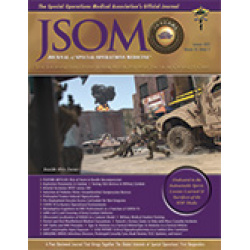Epidemiology of Musculoskeletal Injuries Among Naval Special Warfare Personnel
Lovalekar M, Keenan KA, Bird M, Cruz DE, Beals K, Nindl BC 99(5). 36 - 42 (Journal Article)
Background: Musculoskeletal injuries (MSIs) are an important cause of morbidity in the military, especially among Special Forces. The aim of this analysis was to describe MSIs among two groups of Naval Special Warfare (NSW) personnel-Special Warfare Combatant-Craft Crewman (SWCC) Operators and Crewman Qualification Training (CQT) students. Methods: In this cross-sectional study, we describe self-reported MSIs that occurred during a one-year period and the calculated financial costs of MSIs. Group comparisons were conducted using Fisher's exact tests and independent samples t tests. Results: Data were available for 142 SWCC Operators (26.9 ± 5.9 years, 1.8 ± 0.1 meters, 85.4 ± 10.4 kilograms) and 187 CQT students (22.8 ± 3.2 years, 1.8 ± 0.2 meters, 81.4 ± 8.9 kilograms). The one-year cumulative MSI incidence was significantly lower among SWCC Operators (21.1%) compared to CQT students (37.4%, p = 0.002). The most common anatomic location for MSIs was the lower extremity (SWCC: 50.0% of MSIs, CQT: 66.3%). Physical training was the predominant activity when MSIs occurred (SWCC: 31.6%, CQT: 77.6%). The lifetime cost of all the MSIs included in the analysis was approximately $580,000 among 142 SWCC Operators and $1.2 million among 187 CQT students. Conclusion: MSIs, especially those affecting the lower extremity and occurring during physical training, cause considerable morbidity and financial burden among NSW personnel. Many of the musculoskeletal injuries are to musculotendinous tissue, which typically results from tissue overload or inadequate recovery. Further investigation of the preventable causes of these MSIs and development of a customized, evidence-based MSI prevention program is required to reduce the burden of these MSIs.


 Español
Español 



